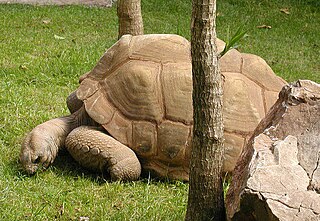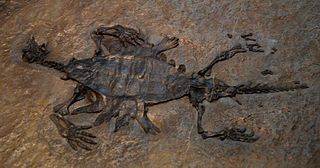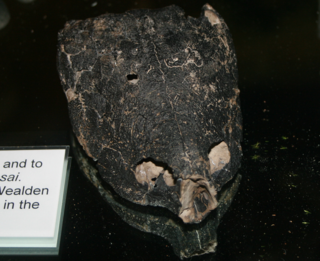The Jurassic is a geologic period and stratigraphic system that spanned from the end of the Triassic Period 201.4 million years ago (Mya) to the beginning of the Cretaceous Period, approximately 145 Mya. The Jurassic constitutes the middle period of the Mesozoic Era and is named after the Jura Mountains, where limestone strata from the period were first identified.

The Cryptodira are a suborder of Testudines that includes most living tortoises and turtles. Cryptodira differ from Pleurodira in that they lower their necks and pull the heads straight back into the shells, instead of folding their necks sideways along the body under the shells' marginals. They include among their species freshwater turtles, snapping turtles, tortoises, softshell turtles, and sea turtles.

Echinodon is a genus of heterodontosaurid dinosaur that lived during the earliest Cretaceous of southern England and possibly western France in the Berriasian epoch. The first specimens were jaw bones named Echinodon becklesii by Sir Richard Owen in 1861, and since their original description only additional teeth have been discovered. The specific name honours collector Samuel Beckles who discovered the material of Echinodon and many other taxa from across England, while the genus name translates as "prickly tooth" in reference to the dental anatomy of the taxon.

The Pleurodira are one of the two living suborders of turtles, the other being the Cryptodira. The division between these two suborders represents a very deep evolutionary divide between two very different types of turtles. The physical differences between them, although anatomical and largely internal, are nonetheless significant, and the zoogeographic implications of them are substantial. The Pleurodira are known more commonly as the side-necked turtles and the name Pleurodira quite literally translates to side neck, whereas the Cryptodira are known as hidden-necked turtles. The Pleurodira turtles are currently restricted to freshwater habitats in the Southern Hemisphere, largely to Australia, South America, and Africa. Within the Pleurodira, three living families are represented: Chelidae, also known as the Austro-South American side-necked turtles, the Pelomedusidae, also known as the African mud terrapins, and the Podocnemididae, also known as the American side-neck river turtles. However, they were cosmopolitan clade during the Cretaceous and most of the Cenozoic, and even occurred in marine environments around the world.

Meiolaniidae is an extinct family of large, probably herbivorous stem-group turtles with heavily armored heads and tails known from South America and Australasia. Though once believed to be cryptodires, they are not closely related to any living species of turtle, and lie outside crown group Testudines, having diverged from them around the Middle Jurassic. They are best known from the last surviving genus, Meiolania, which lived in the rain forests of Australia from the Miocene until the Pleistocene, and insular species that lived on Lord Howe Island and New Caledonia during the Pleistocene and possibly the Holocene for the latter. Meiolaniids are part of the broader grouping of Meiolaniformes, which contains more primitive turtles species lacking the distinctive morphology of meiolaniids, known from the Early Cretaceous-Paleocene of South America and Australia.

Protostegidae is a family of extinct marine turtles that lived during the Cretaceous period. The family includes some of the largest sea turtles that ever existed. The largest, Archelon, had a head one metre (39 in) long. Like most sea turtles, they had flattened bodies and flippers for front appendages; protostegids had minimal shells like leatherback turtles of modern times.

Paracryptodira is an extinct group of reptiles in the clade Testudinata, known from the Jurassic to Paleogene of North America and Europe. Initially treated as a suborder sister to Cryptodira, they were then thought to be a very primitive lineage inside the Cryptodira according to the most common use of the latter taxon. They are now often regarded as late-diverging stem-turtles, lying outside the clade formed by Cryptodira and Pleurodira. The paracryptodires are said to have phylogenic relationships, noted as primary subclades, within the Baenidae and Pleurosternidae. Within each subclade, lies many biodiverse turtles that are continuously being investigated and added to the fossil record. Paracryptodires are divided into three main groups, Compsemydidae, known from the Late Jurassic to Paleocene of North America and Europe, Pleurosternidae, known from the Late Jurassic to Early Cretaceous of North America and Europe, and Baenidae, known from the Early Cretaceous to Eocene of North America. The latter two groups are more closely related to each other than to Compsemys, forming the clade Baenoidea.

Testudinata is the group of all tetrapods with a true turtle shell. It includes both modern turtles (Testudines) and many of their extinct, shelled relatives (stem-turtles). Though it was first coined as the group containing turtles by Jacob Theodor Klein in 1760, it was first defined in the modern sense by Joyce and colleagues in 2004. Testudinata does not include the primitive stem-turtle Odontochelys, which only had the bottom half of a shell. A recent phylogenetic tree of Testudinata included Angolachelonia and Testudines as sister-taxa and subgroups of Testudinata.
Compsemys is an extinct genus of prehistoric turtles from the Late Cretaceous and Paleocene of North America and possibly Europe. The type species C. victa, first described by Joseph Leidy from the Hell Creek Formation in Montana in 1856, and another probable species C. russelli, described in 2012, from Paleocene deposits in France. Its affinites have long been uncertain, but it has recently been considered to be the most basal member of Paracryptodira, despite the clade first appearing in the Late Jurassic, and is sometimes included in its own family, Compsemydidae. A revision in 2020 found Compsemydidae to be more expansive, also containing Riodevemys and Selenemys from the Late Jurassic of Europe, and Peltochelys from the Early Cretaceous of Europe.
Gamerabaena is an extinct genus of baenid turtle which existed in North Dakota during the late Cretaceous Period. It is known from a single fragmentary skull that was found in the Maastrichtian-age Hell Creek Formation. It contains the species Gamerabaena sonsalla. Gamerabaena is similar to the genus Palatobaena, but it differs in its lack of a posterior expansion of the triturating surface, a somewhat rectangular skull, and a wide angle between the maxillae. Gamerabaena also has a lingual ridge on the inner side of the jaw that is not seen in Palatobaena.

Reptiles arose about 320 million years ago during the Carboniferous period. Reptiles, in the traditional sense of the term, are defined as animals that have scales or scutes, lay land-based hard-shelled eggs, and possess ectothermic metabolisms. So defined, the group is paraphyletic, excluding endothermic animals like birds that are descended from early traditionally-defined reptiles. A definition in accordance with phylogenetic nomenclature, which rejects paraphyletic groups, includes birds while excluding mammals and their synapsid ancestors. So defined, Reptilia is identical to Sauropsida.

Pleurosternon is an extinct genus of freshwater pleurosternid turtle from the latest Jurassic to earliest Cretaceous of Europe. Its type species, P. bullocki was described by the paleontologist Richard Owen in 1853. Since then, and throughout the late 19th century, many fossil turtles were incorrectly assigned to this genus, though only two are currently considered valid.

Pantestudines or Pan-Testudines is the group of all reptiles more closely related to turtles than to any other living animal. It includes both modern turtles and all of their extinct relatives.

Macrobaenidae is an extinct family of turtles, known from the Early Cretaceous to Paleogene of Laurasia. Their relationships to other turtles and whether or not they form a monophlyletic group are controversial. They are typically interpreted as stem or crown group cryptodires, but some more recent analyses have found them to lie outside crown group Testudines. Macrobaenids can be distinguished from other testudinatans by the presence of a carotid fenestra, cruciform plastron with strap-like epiplastra, and a lack of extragulars.

Sichuanchelyidae is a family of extinct turtles in the clade Testudinata. It includes all perichelydians that are more closely related to Sichuanchelys than Meiolania, Helochelydra, or any extant turtles.

The Helochelydridae are an extinct family of stem-turtles known from fossils found in North America and Europe spanning the Early to Late Cretaceous.

Helochelydra is an extinct genus of extinct stem turtle known from the Early Cretaceous (Barremian) of the Isle of Wight, southern England.

Meiolaniformes is an extinct clade of stem-group turtles, defined as all taxa more closely related to Meiolania than to Cryptodira and Pleurodira. It is known from the Early Cretaceous to the Holocene of Australia, Oceania and South America. Some Eurasian taxa have been suggested to be part of the group, but this is disputed.

Mesochelydia is a clade within Pantestudines, more inclusive than Perichelydia, but less than Testudinata. The clade is known from the Early Jurassic to the Present, and contains all Jurassic representatives of Testudinata aside from Australochelys. The ancestral condition for Mesochelydia is thought to be aquatic, as opposed to terrestrial for Testudinata. They are distinguished from more basal testudinatans by the presence of the following characters: strap like pectoral girdle, supramarginals absent, reduced posterior entoplastral process, eleven pairs of peripherals, elongate processus interfenestralis, paired basioccipital tubercles, fully formed cavum tympani and antrum postoticum, single vomer, confluent external nares, lacrimals and supratemporals absent.

Thalassochelydia is a clade of extinct marine turtles from the Late Jurassic and earliest Cretaceous of Europe and South America. The group is defined as including Eurysternum, Plesiochelys and Thalassemys to the exclusion of Pelomedusa, Testudo and Protostega. While a clade uniting the families Eurysternidae, Plesiochelyidae and Thalassemydidae had been supported by phylogenetic evidence, a name was not given for the clade until 2017, when Jérémy Anquetin and colleagues coined Thalassochelydia.



















